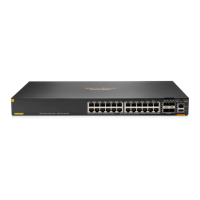448
Task Command
Display IPv4SG bindings.
display ip source binding
[
static
| [
vpn-instance
vpn-instance-name ]
[
arp-snooping
|
dhcp-relay
|
dhcp-server
|
dhcp-snooping
|
dot1x
] ]
[
ip-address
ip-address ] [
mac-address
mac-address ] [
vlan
vlan-id ]
[
interface
interface-type interface-number ] [
slot
slot-number ]
Display IPv6SG bindings.
display ipv6 source binding
[
static
| [
vpn-instance
vpn-instance-name ]
[
dhcpv6-relay
|
dhcpv6-snooping
|
dot1x
] ] [
ip-address
ipv6-address ]
[
mac-address
mac-address ] [
vlan
vlan-id ] [
interface
interface-type
interface-number ] [
slot
slot-number ]
IPSG configuration examples
Static IPv4SG configuration example
Network requirements
As shown in Figure 122, all hosts use static IP addresses.
Configure static IPv4SG bindings on Device A and Device B to meet the following requirements:
• Ten-GigabitEthernet 1/0/2 of Device A allows only IP packets from Host C to pass.
• Ten-GigabitEthernet 1/0/1 of Device A allows only IP packets from Host A to pass.
• All interfaces of Device B allow IP packets from Host A to pass.
• Ten-GigabitEthernet 1/0/1 of Device B allows IP packets from Host B to pass.
Figure 122 Network diagram
Configuration procedure
1. Configure Device A:
# Configure IP addresses for the interfaces. (Details not shown.)
# Enable IPv4SG on Ten-GigabitEthernet 1/0/2.
<DeviceA> system-view
[DeviceA] interface ten-gigabitethernet 1/0/2
[DeviceA-Ten-GigabitEthernet1/0/2] ip verify source ip-address mac-address
# On Ten-GigabitEthernet 1/0/2, configure a static IPv4SG binding for Host C.
[DeviceA-Ten-GigabitEthernet1/0/2] ip source binding ip-address 192.168.0.3
mac-address 0001-0203-0405
[DeviceA-Ten-GigabitEthernet1/0/2] quit
# Enable IPv4SG on Ten-GigabitEthernet 1/0/1.
IP: 192.168.0.3/24
MAC : 0001-0203-0405
IP: 192.168.0.1/24
MAC: 0001-0203-0406
Host A
IP: 192.168.0.2/24
MAC: 0001-0203-0407
Host B
Host C
XGE1/0/2
XGE1/0/1
XGE1/0/2
XGE1/0/1
Device A
Device B

